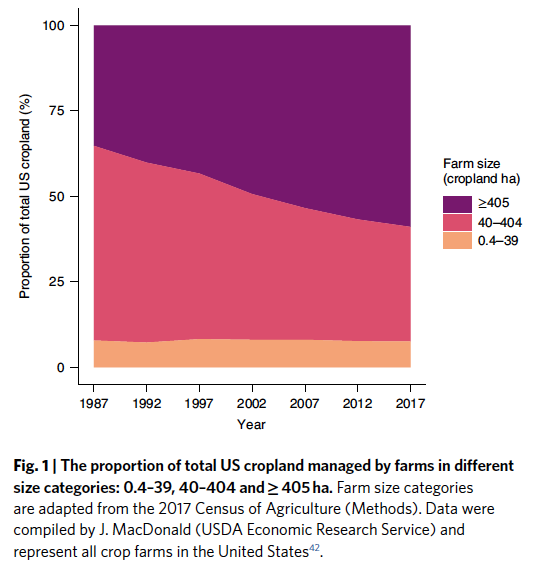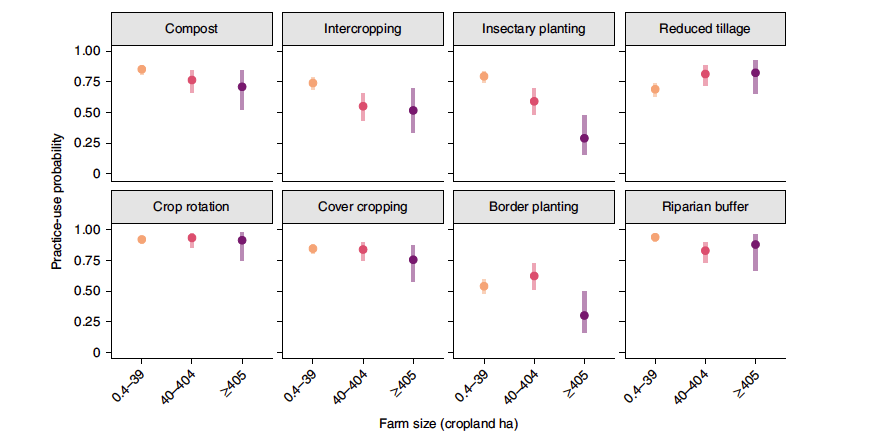“Championing this transition in the 1970s, former US Secretary of Agriculture, Earl Butz, declared that farmers should ‘get big or get out’. Since then, the average size of US farms has increased.”
As the graph shows, those gains came through the disappearance of the middle-size farm; small family farms  remained relatively constant. Today 1% of US land is involved in organic farming and ranching. But because of perceived health benefits, organic punches above its weight class. Its purported benefits to the land, specifically to soil quality and the provision of “ecosystem service” (fertilization, pollination, weed, and pest control), are captured in the USDA’s National Organic Program.
remained relatively constant. Today 1% of US land is involved in organic farming and ranching. But because of perceived health benefits, organic punches above its weight class. Its purported benefits to the land, specifically to soil quality and the provision of “ecosystem service” (fertilization, pollination, weed, and pest control), are captured in the USDA’s National Organic Program.
The current study surveyed 542 organic fruit and vegetable farmers, looking at eight agroecological practices, categorizing adherence to these practices based on farm size. Those services included
- Compost or manure application in place of synthetic fertilizers
- Intercropping – the simultaneous growing of two crops in the same rows to get the enhanced benefits of each. Examples include garlic and tomatoes.
- Insectary plantings to enhance the presence of beneficial insects
- Reduced tillage of the soil to maintain its composition and integrity
- Diverse crop rotation (3 or more) to hedge against lower yields and crop loss
- Cover cropping planting “off-season” to damp down weeds and reinfuse the soil with nitrogen. Mustard makes for a beautiful cover crop blooming in early spring in the Napa vineyards.
- Border planting to provide food for those beneficial insects increasing pollination and enhancing pest control
- Riparian buffers that serve to contain run-off, providing borders between crops
As the graphic demonstrates, small farms used more agroecological practices, but a more significant variance was found as farm size increased.

Because of the scale of large farm operations, the use of border and insectary planting was inefficient; the attracted insects did not penetrate the center of the fields. On the other hand, larger farms had the capital to invest in machinery to reduce tillage, which was more hand work for the smaller farmers. 54% of small farms used little mechanization, and only 3% of large farms were not mechanized.
The researchers also describe four characteristics of conventional farming, “low crop diversity, high mechanization, wholesale marketing, and non-local market access.” As would be expected, large organic farms utilized more of these practices.
Scale makes a difference
The ability to scale up results in fewer agroecological practices being followed, but in return, there is a larger market and the ability to obtain the various organic certifications (as Dr. Caldwell has written). The small farmer can’t access larger markets and is destined to sell primarily within their community. Moreover, they do not have the margins necessary to complete organic regulatory paperwork, while ironically being more “organic” than those larger farms. As with many industries, the greatest enemy of a small business is big business.
[1] Organic sales soar in 2020 to over $61 billion
Source: Farm size affects the use of agroecological practices on organic farms in the United States. Nature Plants DOI: 10.1038/s41477-022-01191-1




